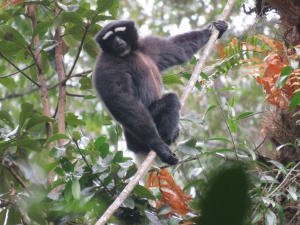Nearly 300 mammal species have been recorded in Myanmar, but a number of these have not been sighted in recent years, including the Sumatran rhinoceros (Dicerorhinus sumatrensis ), Javan rhinoceros (Rhinoceros sondaicus) and Indian water buffalo (Bubalus amee).



Myanmar is home to the Western Hoolock gibbon (Hoolock hoolock), Eastern Hoolock gibbon (Hoolock leuconedys) and Myanmar snub-nosed monkey (Rhinopithecus strykeri), discovered in the mountains near the Chinese border in north-east Kachin State in 2010.
There are 47 globally threatened mammal species in Myanmar, five Critically Endangered, 17 Endangered and 25 Vulnerable.




Two large mammals, the Asian elephant (Eiephas maximus) and tiger (Panthera tigris) are threatened, mainly due to illegal trafficking, and their populations are thought to be decreasing. Black musk deer (Moschus fuscus), sun bear(Helarctos malayans), Malayan pangolin (Manis javanica) and Chinese pangolin (Manis pentadactyla) are also severely threatened by illegal trafficking. On the other hand, camera trap surveys have shown that Htamathi Wildlife Sanctuary, and the proposed Taninthayi, lenya and lenya (extension) National Parks are home to a considerable number of tigers and prey species, as well as the Asian elephant.
The population of the Irrawaddy dolphin (Orcaella brevirostris) has been decreasing, mainly due to destructive electrofishing practices. Another large aquatic mammal, the dugong (Dugong dugan), has been sighted in the Myeik Archipelago and off the Rakhine coast. Myanmar is also home to at least five endemic mammal species, including: Anthony’s pipistrelle (Hypsugo anthonyi), Joffre’s pipistrelle (Hypsugo joffrei), Myanmar pipistrelle (Hypsugo
lophurus) and the Popa soft-furred rat (Millardia kathleenae). Dry mixed deciduous forests in Myanmar are home to the largest remaining population of the endangered Eld’s deer (Rucervus eldii).
